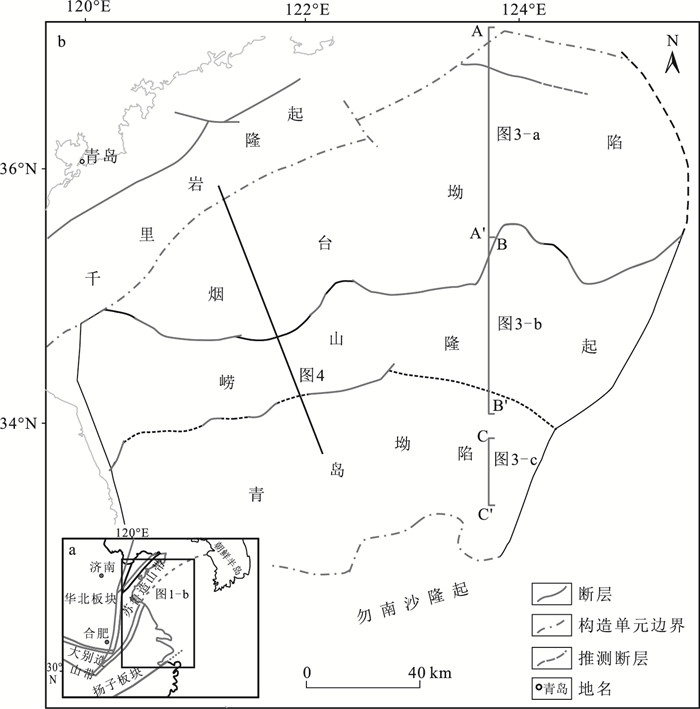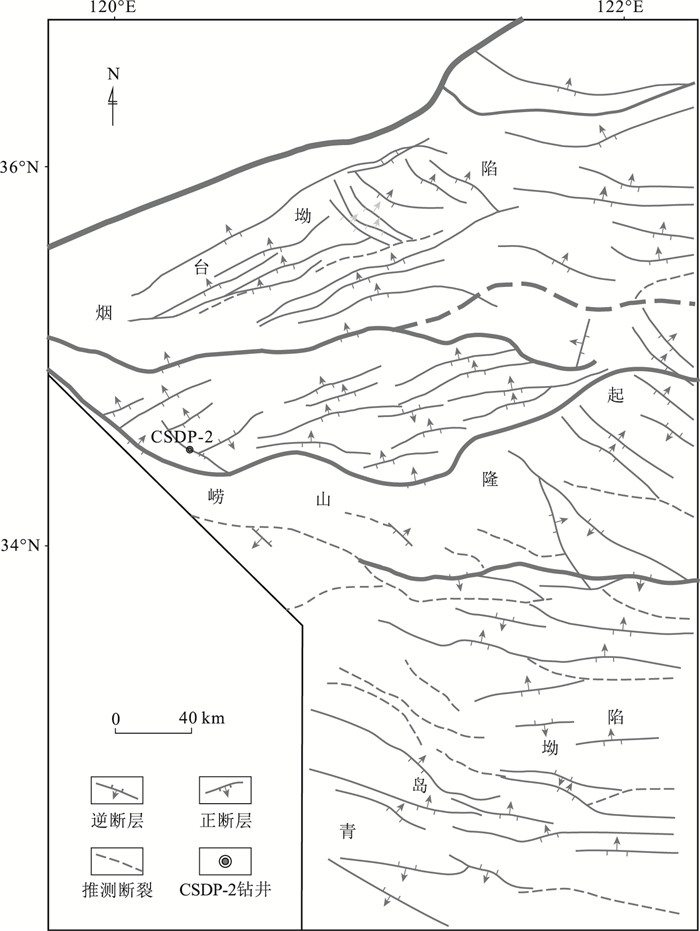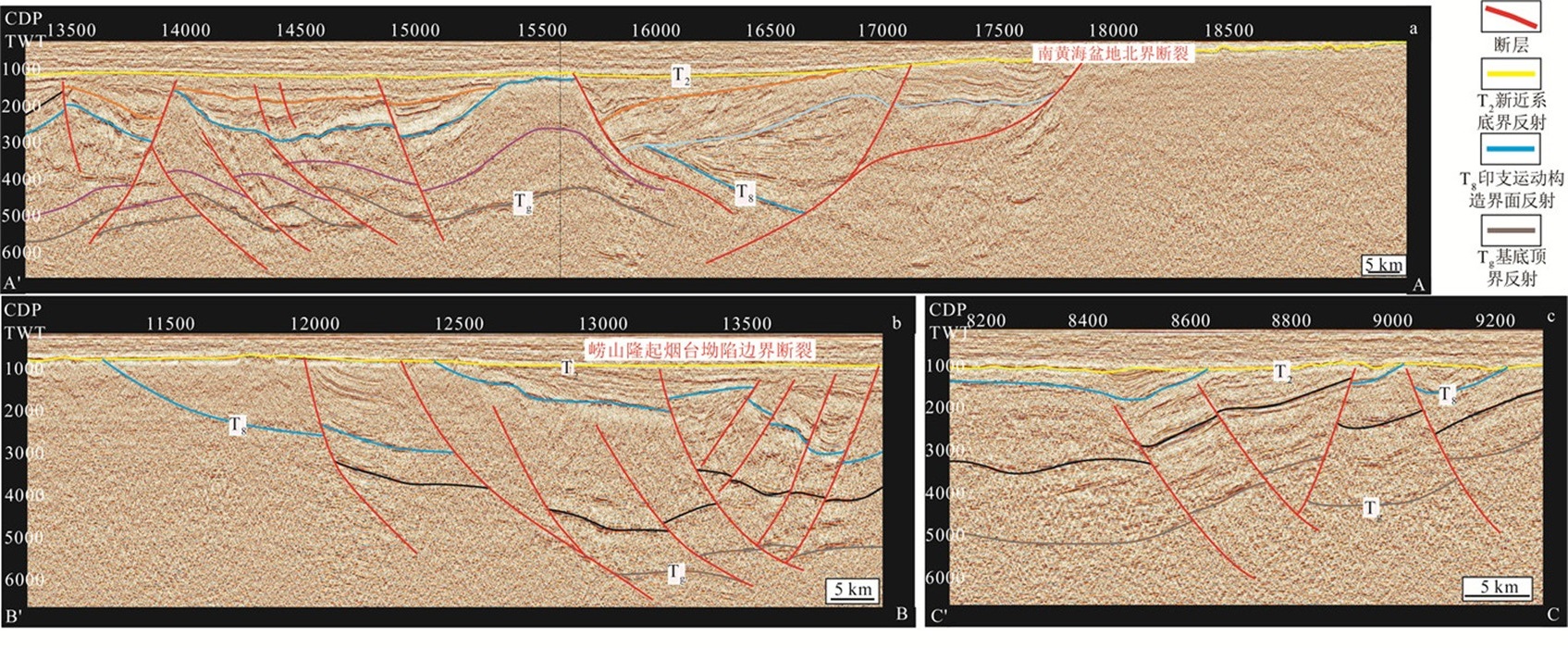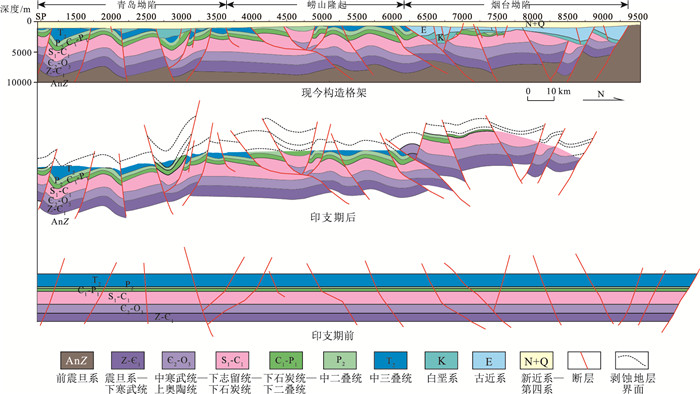The response of the Indosinian Movement to the South Yellow Sea basin and its influence on the hydrocarbon geological conditions
-
摘要:
南黄海盆地位于扬子地块东缘,占据了下扬子地块的主体,其构造演化过程可与中—上扬子区类比。南黄海盆地自震旦纪以来,经历了多期构造演化过程,其中印支运动在盆地的定型及改造过程中起到了至关重要的作用,但印支运动在盆地不同部位的构造响应特征及其油气地质意义并不明确。依据南黄海盆地多年的研究成果,结合最新区域地震、钻井等资料,认为印支运动在南黄海盆地不同区域具有不同的构造表现。盆地中部崂山隆起受印支运动影响最弱,之后拉伸构造反转作用也相对最弱,南部青岛坳陷次之,而北部烟台坳陷受印支运动影响最强烈。从油气地质条件看,印支运动对不同期次油气藏具有不同影响,对下古生界油气藏具有调整改造作用,对于上古生界的圈闭具有定型作用。印支运动断裂系统对深部油气的疏导、储层裂缝的发育具有积极意义。
Abstract:The South Yellow Sea basin is located at the eastern margin of Yangtze Platform and dominated the Lower Block, whose tectonic evolution can be correlated with Middle-Upper Yangtze region.The South Yellow Sea basin had suffered several tectonic evolution phases since Sinian, of which the Indosinian Movement had played a key role in basin formation and modification.However, the tectonic response of the Indosinian Movement to different parts of the basin and its petroleum geological significance are not clear.Based on the research results of the South Yellow Sea Basin for many years, combined with new regional seismic and drilling data, it is concluded that the Indosinian Movement had different tectonic manifestations in different regions of the South Yellow Sea Basin.The Laoshan uplift in the middle of the basin was the least affected, and the subsequent tension inversion was also relatively weak.While, the Yantai depression in the north was the most strongly affected by the Indosinian Movement, followed by the Qingdao depression in the south.As to geological conditions of hydrocarbon mineralization, it had different effects on the sub-reservoirs of different periods.Which had modified the oil and gas reservoir in the Lower Paleozoic and finalized ones in the Upper Paleozoic.The fault system has also positive significance for the drainage of deep hydrocarbon and the development of reservoir fissure.
-

-
[1] 任纪舜. 印支运动及其在中国大地构造演化中的意义[J]. 地球学报, 1984, 6(2): 31-44. https://www.cnki.com.cn/Article/CJFDTOTAL-DQXB198402003.htm
[2] 黄汲清. 中国主要地质构造单位[M]. 北京: 地质出版社, 1994.
[3] 王鸿祯, 杨森楠, 李思田. 中国东部及邻区中、新生代盆地发育及大陆边缘区的构造发展[J]. 地质学报, 1983, 3: 3-13. https://www.cnki.com.cn/Article/CJFDTOTAL-DZXE198303000.htm
[4] 张岳桥, 董树文, 李建华, 等. 华南中生代大地构造研究新进展[J]. 地球学报, 2012, 33(3): 257-279. https://www.cnki.com.cn/Article/CJFDTOTAL-DQXB201203001.htm
[5] 李三忠, 刘鑫, 索艳慧, 等. 华北克拉通东部地块和大别-苏鲁造山带印支期褶皱-逆冲构造与动力学背景[J]. 岩石学报, 2009, 25(9): 3-21. https://www.cnki.com.cn/Article/CJFDTOTAL-YSXB200909001.htm
[6] 陈建文, 雷宝华, 梁杰, 等. 南黄海盆地油气资源调查新进展[J]. 海洋地质与第四纪地质. 2018, 38(3): 1-23. https://www.cnki.com.cn/Article/CJFDTOTAL-HYDZ201803001.htm
[7] 王社教, 王兰生, 黄金亮, 等. 上扬子区志留系页岩气成藏条件[J]. 天然气工业, 2009, 5: 45-50. https://www.cnki.com.cn/Article/CJFDTOTAL-TRQG200905009.htm
[8] 徐政语, 姚根顺, 梁兴, 等. 扬子陆块下古生界页岩气保存条件分析[J]. 石油实验地质, 2015, 37(4): 407-417. https://www.cnki.com.cn/Article/CJFDTOTAL-SYSD201504002.htm
[9] 祁江豪. 南黄海盆地中-古生界构造演化及与四川盆地对比分析[D]. 中国地质大学(北京)硕士学位论文, 2012.
[10] 侯方辉, 张志珣, 张训华, 等. 南黄海盆地地质演化及构造样式地震解释[J]. 海洋地质与第四纪地质, 2008, 28(5): 61-68. https://www.cnki.com.cn/Article/CJFDTOTAL-HYDZ200805013.htm
[11] 梁杰, 陈建文, 张银国, 等. 南黄海盆地中、古生界盖层条件[J]. 现代地质, 2016, 30(2): 353-360. doi: 10.3969/j.issn.1000-8527.2016.02.010
[12] 刘东鹰. 苏北-南黄海盆地的构造演化分析[J]. 石油天然气学报, 2010, 32(6): 27-31. doi: 10.3969/j.issn.1000-9752.2010.06.006
[13] 庞玉茂, 张训华, 肖国林, 等. 下扬子南黄海沉积盆地构造地质特征[J]. 地质论评, 2016, 62(3): 604-616. https://www.cnki.com.cn/Article/CJFDTOTAL-DZLP201603006.htm
[14] 杨长清, 董贺平, 李刚. 南黄海盆地中部隆起的形成与演化[J]. 海洋地质前沿, 2014, 30(7): 17-21, 33. https://www.cnki.com.cn/Article/CJFDTOTAL-HYDT201407004.htm
[15] 陈建文, 梁杰, 张银国, 等. 中国海域油气资源潜力分析与黄东海海域油气资源调查进展[J]. 海洋地质与第四纪地质, 2019, 39(6): 1-29. https://www.cnki.com.cn/Article/CJFDTOTAL-HYDZ201906001.htm
[16] 陈建文, 施剑, 刘俊, 等. 南黄海海相中-古生界地震地质条件[J]. 海洋地质前沿, 2016, 32(10): 1-8. https://www.cnki.com.cn/Article/CJFDTOTAL-HYDT201610001.htm
[17] 陈建文, 施剑, 张异彪, 等. 地震调查技术突破南黄海海相中-古生界成像技术瓶颈[J]. 地球学报, 2017, 38(6): 847-858. https://www.cnki.com.cn/Article/CJFDTOTAL-DQXB201706001.htm
[18] 陈建文, 张异彪, 刘俊, 等. 南黄海"高富强"地震勘查技术及其应用[J]. 海洋地质前沿, 2016, 32(10): 9-17. https://www.cnki.com.cn/Article/CJFDTOTAL-HYDT201610002.htm
[19] 陈建文, 许明, 雷宝华, 等. 华北-扬子板块碰撞结构的识别: 来自南黄海海域的证据[J]. 海洋地质与第四纪地质, 2020, 185(3): 3-14. https://www.cnki.com.cn/Article/CJFDTOTAL-HYDZ202003001.htm
[20] 蔡乾忠. 中国东部与朝鲜大地构造单元对应划分[J]. 海洋地质与第四纪地质, 1995, 1: 7-24. https://www.cnki.com.cn/Article/CJFDTOTAL-HYDZ501.001.htm
[21] 蔡乾忠. 中国海域油气地质学[M]. 北京: 海洋出版社, 2005.
[22] 佘晓宇, 徐宏节, 何治亮. 江苏下扬子区中、古生界构造特征及其演化[J]. 石油与天然气地质, 2004, 2: 226-230. https://www.cnki.com.cn/Article/CJFDTOTAL-SYYT200402018.htm
[23] 夏邦栋. 下扬子前中生代构造演化[J]. 成都理工学院学报, 1998, 25(2): 145-152. https://www.cnki.com.cn/Article/CJFDTOTAL-CDLG802.008.htm
[24] 朱光, 徐嘉炜, 刘国生, 等. 下扬子地区前陆变形构造格局及其动力学机制[J]. 中国区域地质, 1999, 18(1): 73-79. doi: 10.3969/j.issn.1671-2552.1999.01.012
[25] 陈建文, 梁杰, 张银国, 等, 杨艳秋, 杨传胜, 孙晶. 中国海域油气资源潜力分析与黄东海海域油气资源调查进展[J]. 海洋地质与第四纪地质, 2019, 39(6): 1-29. https://www.cnki.com.cn/Article/CJFDTOTAL-HYDZ201906001.htm
[26] 梁杰, 陈建文, 张银国, 等. 南黄海盆地中、古生界盖层条件[J]. 现代地质, 2016, 30(2): 353-360. doi: 10.3969/j.issn.1000-8527.2016.02.010
[27] 梁杰, 张鹏辉, 陈建文, 等. 南黄海盆地中-古生代海相地层油气保存条件[J]. 天然气工业, 2017, 37(5): 10-19. https://www.cnki.com.cn/Article/CJFDTOTAL-TRQG201705004.htm
[28] 李慧君. 南黄海盆地海相中-古生界构造区划[J]. 海洋地质前沿, 2014, 30(10): 8-13. https://www.cnki.com.cn/Article/CJFDTOTAL-HYDT201410002.htm
[29] Li S Z, Jahn B M, Zhao S J, et al. Triassic southeastward subduction of North China Block to South China Block: Insights from new geological, geophysical and geochemical data[J]. Earth-Science Reviews, 2017, 166: 270-285. doi: 10.1016/j.earscirev.2017.01.009
[30] Xu M, Chen J, Liang J, et al. Basement structures underneath the northern South Yellow Sea basin (East China): Implications for the collision between the North China and South Chinablocks[J]. Journal of Asian Earth Sciences, 2019, 186: 104040. doi: 10.1016/j.jseaes.2019.104040
[31] Zhang X H, Yang J Y, Li G, et al. Basement Structure and Distribution of Mesozoic-Paleozoic Marine Strata in the South Yellow Sea Basin[J]. Chinese Journal of Geophysics, 2015, 58(1): 96-107. doi: 10.1002/cjg2.20158
[32] 杨琦, 陈红宇. 苏北-南黄海盆地构造演化[J]. 石油实验地质, 2003, 25(s1): 562-565. https://www.cnki.com.cn/Article/CJFDTOTAL-SYSD2003S1008.htm
[33] 刘东鹰. 苏北-南黄海盆地的构造演化分析[J]. 石油天然气学报, 2010, 32(6): 27-31. doi: 10.3969/j.issn.1000-9752.2010.06.006
[34] 杨长清, 董贺平, 李刚. 南黄海盆地中部隆起的形成与演化[J]. 海洋地质前沿, 2014, 30(7): 17-21, 33. https://www.cnki.com.cn/Article/CJFDTOTAL-HYDT201407004.htm
[35] 肖国林, 蔡来星, 郭兴伟, 等. 大陆架科学钻探CSDP-2井揭示的南黄海中-古生界油气地质特征[J]. 海洋地质前沿, 2019, (8): 73-76. https://www.cnki.com.cn/Article/CJFDTOTAL-HYDT201908010.htm
[36] 许明, 陈建文, 雷宝华, 等. 南黄海海域中生代前陆盆地形成的构造背景[J]. 现代地质, 2019, 33(1): 13-24. https://www.cnki.com.cn/Article/CJFDTOTAL-XDDZ201901002.htm
[37] 高顺莉, 谭思哲, 侯凯文, 等. 南黄海海域侏罗系分布与构造意义[J]. 海洋地质前沿, 2015, 31(4): 7-12. https://www.cnki.com.cn/Article/CJFDTOTAL-HYDT201504002.htm
[38] 杜建波, 何明喜, 张艳霞, 等. 下扬子北缘前陆盆地构造演化及沉积特征[J]. 石油实验地质, 2007, 29(2): 133-137. https://www.cnki.com.cn/Article/CJFDTOTAL-SYSD200702006.htm
[39] 高顺莉, 周祖翼. 南黄海盆地东北凹侏罗纪地层的发现及其分布特征[J]. 高校地质学报, 2014, 20(2): 286-293. doi: 10.3969/j.issn.1006-7493.2014.02.013
[40] Cai L, Xiao G, Guo X, et al. Assessment of Mesozoic and Upper Paleozoic source rocks in the South Yellow Sea Basin based on the continuous borehole CSDP-2[J]. Marine & Petroleum Geology, 2019, 101: 30-42. http://www.sciencedirect.com/science/article/pii/S0264817218304987
[41] Chen J, Xu M, Lei B, et al. Prospective prediction and exploration situation of marine Mesozoic-Paleozoic oil and gas in the South Yellow Sea[J]. China Geology, 2019, 2(1): 67-84. doi: 10.31035/cg2018072
[42] 梁杰. 构造作用对南黄海盆地三叠系青龙组储层的影响[J]. 海洋地质前沿, 2014, 30(10): 57-61. https://www.cnki.com.cn/Article/CJFDTOTAL-HYDT201410010.htm
-




 下载:
下载:


